Sikalidis C. (ed.) Advances in Ceramics - Synthesis and Characterization, Processing and Specific Applications
Подождите немного. Документ загружается.

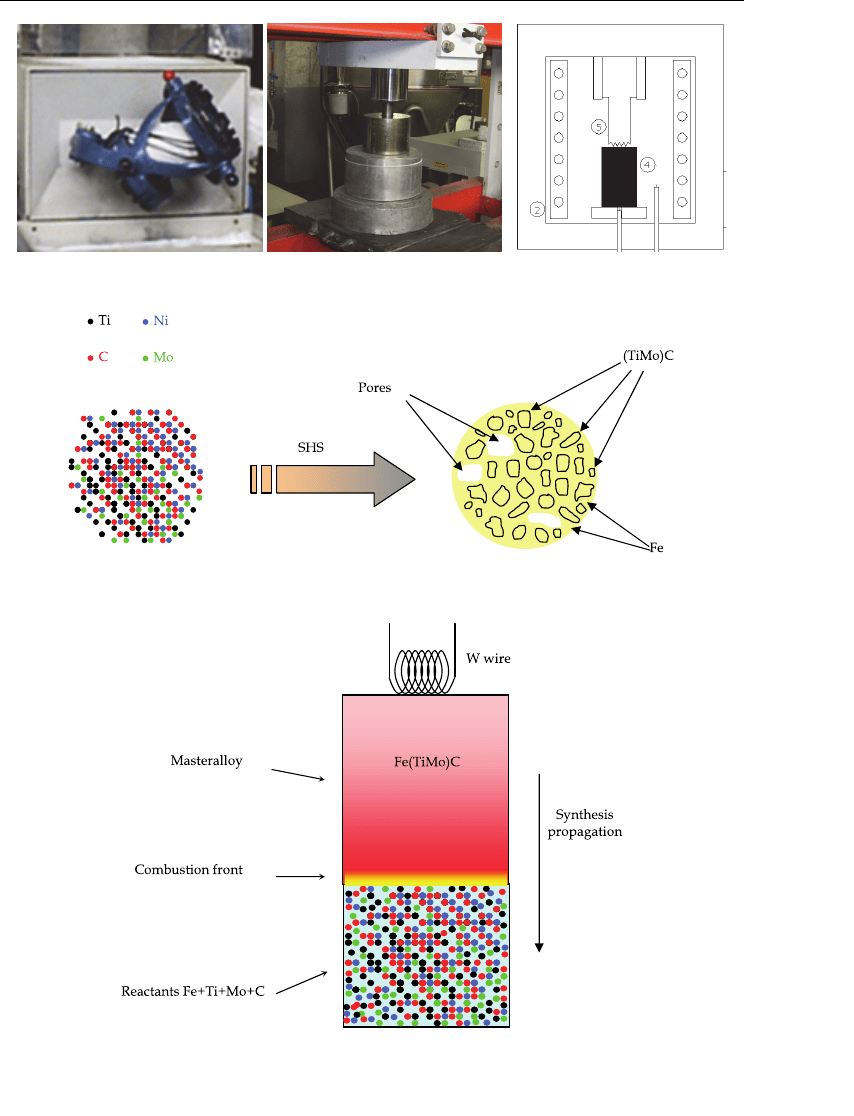
Reinforcement of Austenitic Manganese Steel with
(TiMo) Carbide Particles Previously Synthesized by SHS
369
Fig. 7. Powder mixer (left); Powder press (centre); SHS reactor (right)
Fig. 8. Masteralloy formation (Erausquin, 2009)
Fig. 9. Synthesis self-propagation
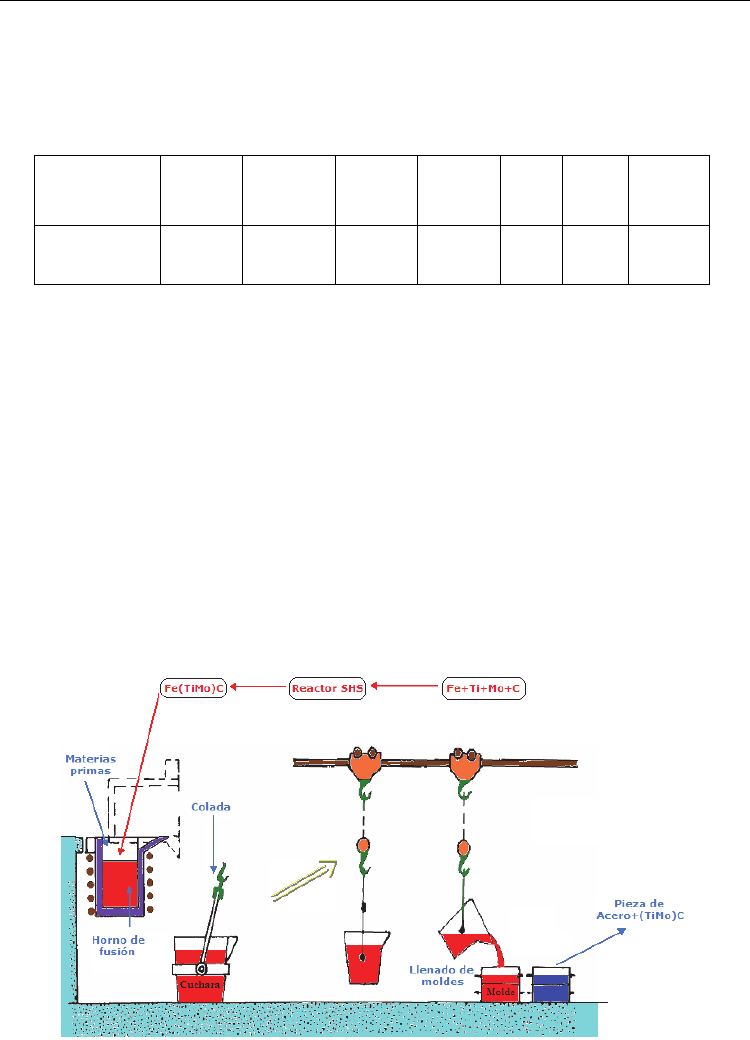
Advances in Ceramics - Synthesis and Characterization, Processing and Specific Applications
370
2.2 Melting of steel and masteralloy addition
The base austenitic steel is obtained by melting, in an induction furnace of 300 Kg. of
capacity and 1000 Hz. of frequency, the next raw materials and quantities: 83% carbon steel
scrap; 13% Fe-Mn high carbon and 4% Fe-Mn low carbon, in order to achieve the chemical
composition, in % mass, of the table 1.
C
Si
Mn
P
S
Cr
Ni
Mo
1.00-1.20
0.30
12.0-14.0
0.035
0.010
-
-
-
Table 1. Chemical composition (% mass) of the base steel
The process include the next steps (Erausquin et al., 2009): Melting of the raw materials in
the furnace and heating of the liquid alloy up to 1873ºK.; Addition of the reinforcing
material, consisting in a 10% of weight, over the base steel, of masteralloy Fe(TiMo)C
previously crushed to 2-20 mm. grain size; After that, heating the bath (steel+carbides) up to
pouring temperature (about 1823ºK).
2.3 Pouring, solidification and heat treatment
The resulting liquid material, steel alloy + reinforcing carbides, can be poured to produce
ingots o castings. In this case, we have obtained sample-blocks and industrial castings
solidified in sand molds. After that, these ones have been heat treated (solution annealing at
1373ºK and rapid quenching in water), as the same manner that a conventional austenitic
manganese steel product. The samples for metallographic and mechanical tests have been
prepared from this heat treated material.
The reinforcement full process is schematized in the figure 10.
Fig. 10. Reinforcement process
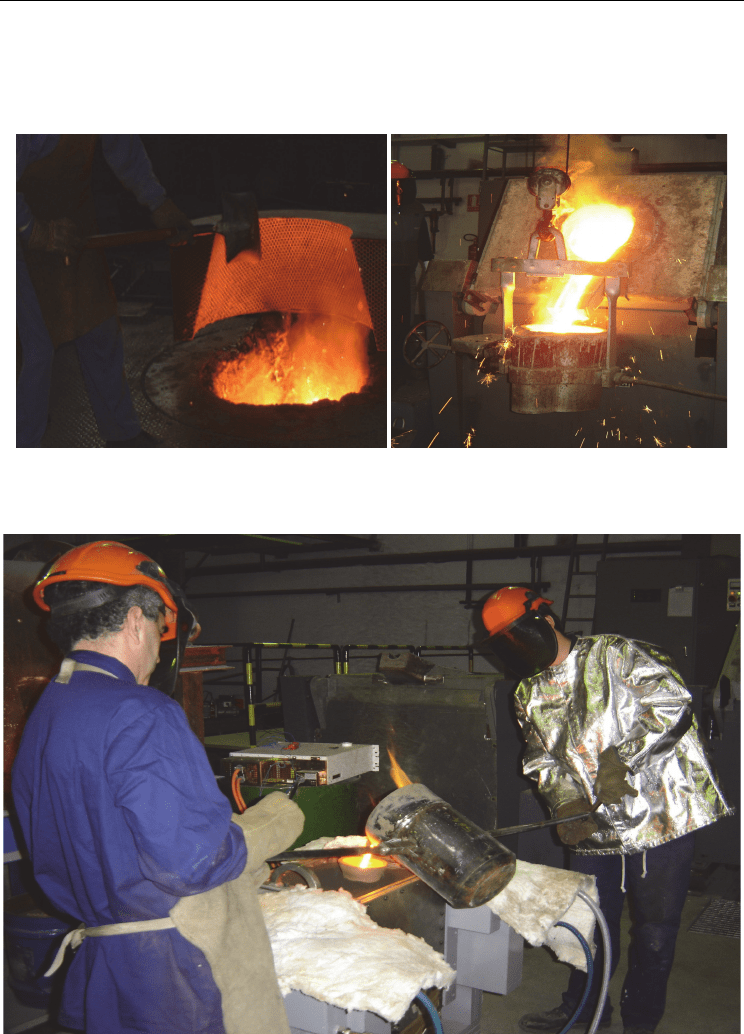
Reinforcement of Austenitic Manganese Steel with
(TiMo) Carbide Particles Previously Synthesized by SHS
371
The figures 11 and 12 show the alloy preparation and pouring, and the mould filling steps,
respectively.
The figure 13 shows the mould filled with reinforced steel.
Fig. 11. Masteralloy addition and pouring of steel+carbides
Fig. 12. Mould filling with steel+carbides

Advances in Ceramics - Synthesis and Characterization, Processing and Specific Applications
372
Fig. 13. Mould filled with steel+carbides
2.4 Characterization
The metallographic characterization has been made by means of optic and electronic
microscopy (SEM with analytical equipment EDS), while the mechanical properties have
been tested by means of a Vickers microhardness tester FM-100, tensile test machine Instron
8034, Charpy test machine Tinius Olsen model 74 and a pin on disk tribometre Biceri (05-
168.02) for wear test. Also, we have used the difractometer Siemens D-500 in order to obtain
the X ray diffraction diagram of samples of masteralloy finely crushed. The peaks of
crystallographic planes of the resultant diffraction tests are contrasted and compared with
those of the JCPDS (Joint Comittee Pattern for Diffraction Standards).
3. Results
3.1 Masteralloy
The visual aspect of the masteralloy produced by SHS is shown in figure 14.
Fig. 14. Blocks of masteralloy Fe(TiMo)C
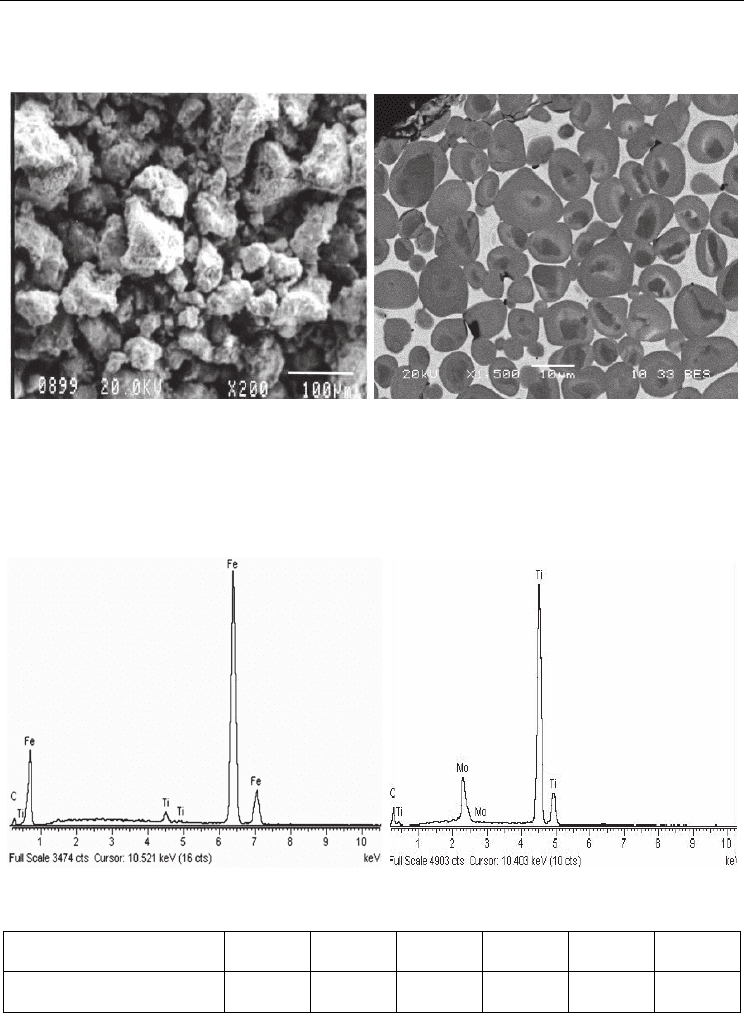
Reinforcement of Austenitic Manganese Steel with
(TiMo) Carbide Particles Previously Synthesized by SHS
373
In the figure 15 is presented the masteralloy crushed (left), and polished (right). In this one,
we can see two constituents: the binder (white) and the polygonal-rounded particles (grey).
Fig. 15. Masteralloy crushed (left), and polished (right)
The figure 16 shows the spectra of the white constituent or binder (left), and of the grey
particle (right). From them, we can deduce that the binder is iron, while the particles could
be complex carbides of titanium and molybdenum. The semicuantitative chemical
composition (obtained by EDS) of these particles is presented in the table 2.
Fig. 16. Binder spectrum (left), particle spectrum (right)
Spectrum Label C Al Ti Fe Mo Total
Grey particle 18.43 68.07 13.50 100.00
Table 2. Semicuantitative composition (% mass) of the masteralloy grey particles

Advances in Ceramics - Synthesis and Characterization, Processing and Specific Applications
374
Besides these results, by means of the X ray diffraction tests we can demonstrate (Erausquin,
2009) the grey particles of the masteralloy are carbides of (TiMo)C type, because being
unknown the θ angle of this complex carbide, the peak of diffraction results in the TiC angle,
as is indicated in the figure 17.
Fig. 17. X ray diffraction of the masteralloy
So that, if the reactants of a SHS reaction are C and Ti, the product is the monocarbide TiC,
while if we add a small quantity of Mo to the mix, the result of the synthesis is the complex
(TiMo)C, with the same crystallographic configuration as the former, but substituting a few
atoms of Ti (green) by Mo ones (red), as indicated in the figures 18 and 19 ( Erausquin, 2009).
Fig. 18. TiC synthesis
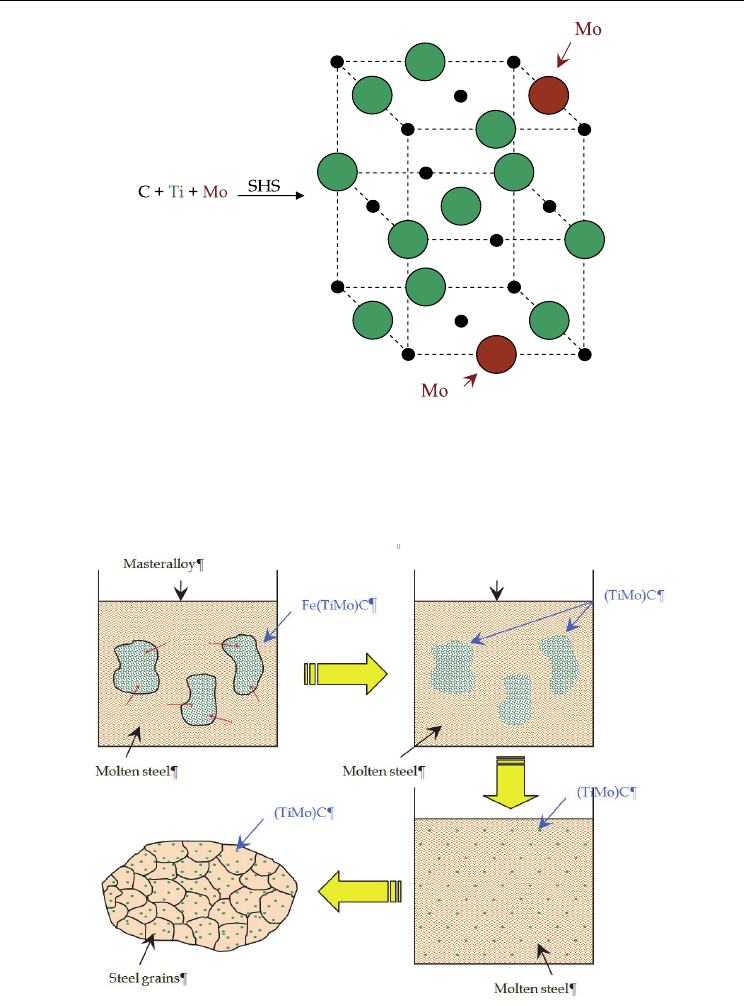
Reinforcement of Austenitic Manganese Steel with
(TiMo) Carbide Particles Previously Synthesized by SHS
375
Fig. 19. (TiMoC synthesis
3.2 Reinforced steel
The mechanism of reinforcement of the steel by the carbides of the masteralloy is
schematized in the figure 20.
Fig. 20. Carbide reinforcement of the steel

Advances in Ceramics - Synthesis and Characterization, Processing and Specific Applications
376
In the figure 21 are shown the castings (hammers for crushing stone) of reinforced steel and
in the figure 22, three hammers working in a rotary mill.
Fig. 21. Castings of reinforced steel
Fig. 22. Three experimental hammers in a rotary mill
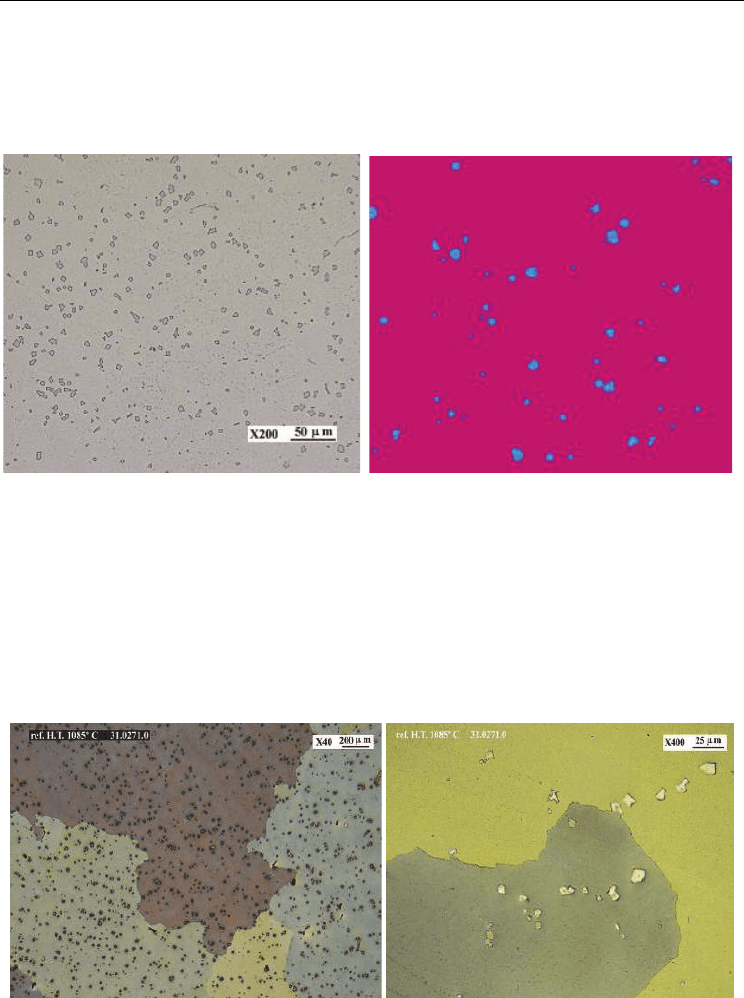
Reinforcement of Austenitic Manganese Steel with
(TiMo) Carbide Particles Previously Synthesized by SHS
377
3.2.1 Microstructure of the reinforced steel
The figure 23 shows the microstructure (unetched) of the reinforced austenitic steel (left),
and the same but obtained with images analyser (right, x400)). In both, we can see discrete,
microscopic and polygonal particles (dark grey at left, blue at right) into matrix (light at left,
red at right).
Fig. 23. Microstructure of the reinforced steel
The figure 24 shows the last microstructure, etched, at 40 and 400 magnifications
respectively, where we can see the former particles inserted within austenite grains.
In the figure 25 we can see the spectra of the matrix of the reinforced steel (left) and of the
particles inserted in it (right). Finally, in the tables 3 and 4 are shown the both
semicuantitative composition (similars to base steel of the table 1 and to the grey particles of
the masteralloy of the table 2, respectively).
Fig. 24. Microstructure of the reinforced steel
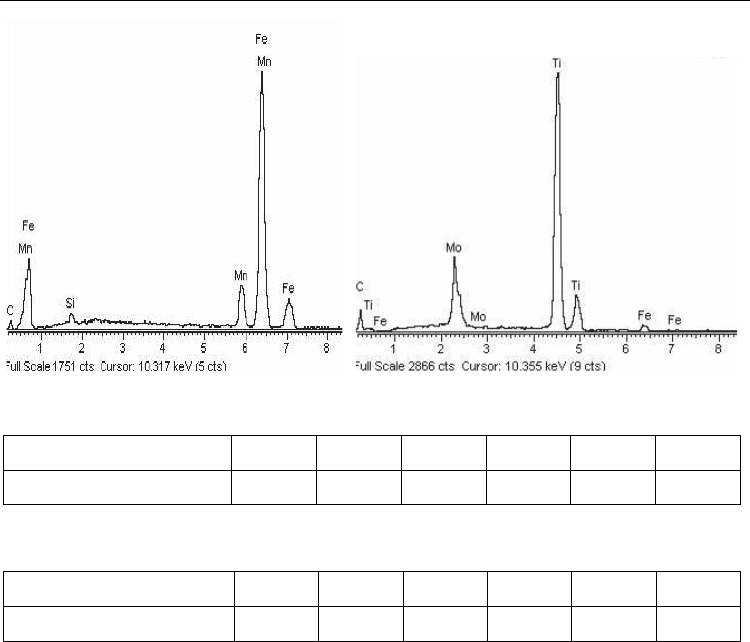
Advances in Ceramics - Synthesis and Characterization, Processing and Specific Applications
378
Fig. 25. Matrix spectrum (left) and particle spectrum (right) in the reinforced steel
Spectrum Label C Al Si Mn Fe Total
Steel matrix 1.15 1.14 12.75 84.96 100.00
Table 3. Semicuantitative composition (% mass) of the matrix of the reinforced steel
Spectrum Label C Al Ti Fe Mo Total
Grey particle 18.62 61.00 2.57 17.81 100.00
Table 4. Semicuantitative composition (% mass) of the particles of the reinforced steel
From them, we can deduce that these particles could be titanium and molybdenum
complex carbides. Their chemical composition (semicuantitative, obtained by EDS) and that
of the grey particles of the masteralloy (table 2) are similar, with a bit more Mo in the former
in detriment of the Ti.
3.2.2 Mechanical properties
3.2.2.1 Hardness.
The microhardness values of the polygonal particles inserted in the austenitic grains of the
reinforced steel are between 2400 and 3100 HV
0.025
. This indicate the particles are carbides.
3.2.2.2 Tensile and Charpy tests.
In the table 5 we can see the values obtained in these tests (according to the norm EN-ISO
6506-1) for Hadfield conventional steel and the reinforced steel of this work. Of these values
we can deduce the reinforced steel is less tough and ductile than the conventional one,
although its toughness is certainly enough for a satisfactory behaviour under impact
conditions. On the other hand, the yield strength of the reinforced steel is higher and, with
